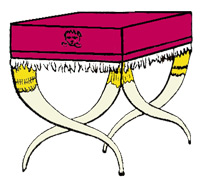
You see an elaborate folding stool embellished with gold and ivory on the magistrate's platform. This curule chair was reserved for high-ranking magistrates and so became a symbol of legitimate political authority. It was frequently depicted on coins during the late Republic and early Empire to validate claims for status and power:
- On this coin issued by the moneyer Q. Cassius Longinus in 55 BCE, the curule chair is shown in the Temple of Vesta. Cassius was alluding to an incident in 113 BCE when one of his ancestors was appointed to investigate charges that several Vestal Virgins accused of incest had been improperly acquitted; the sella indicates the authority given to his ancestor, and the ballot on the side is marked with the two possible votes, A for absolvo ("I acquit") and C for condemno ("I condemn").
- This denarius issued by the moneyer Q. Pompeius Rufus circa 54 BCE depicts curule chairs on both sides, referring to the fact that both of his grandfathers, L. Cornelius Sulla and Q. Pompeius Rufus, were consuls in the same year, 88 BCE.
- When the young triumvir Octavian was struggling to establish his claim to power in 42 BCE, he issued this coin with his portrait on one side and the curule chair of his adoptive father Julius Caesar on the other; the sella bears Caesar's laurel wreath and the inscription CAESAR DIC PER ("Caesar Dictator for Life").
- Octavian issued this denarius sometime before his victory over Antony and Cleopatra at Actium in 31 BCE. The reverse of the coin shows Octavian wearing a toga and sitting on the curule chair, suggesting traditional political authority, but his pose, holding a statue of the winged goddess Victoria, alludes to a famous cult statue of Jupiter, and this divine association is strengthened by the imagery on the other side of the coin, which depicts Jupiter's thunderbolt behind a herm whose wreathed head bears the features of Octavian.
- After Octavian had established his power as Augustus in 27 BCE, he used the curule chair on this gold coin to underline the legitimacy of his new position; the inscription reads LEGES ET IVRA P R RESTITVIT, "he restored the laws and the rights of the Roman people."
Since you are feeling particularly daring, you walk boldly up to the platform in order to take a seat on the sella curulis. Type /sit on sella (don't forget the slash) to see what happens.